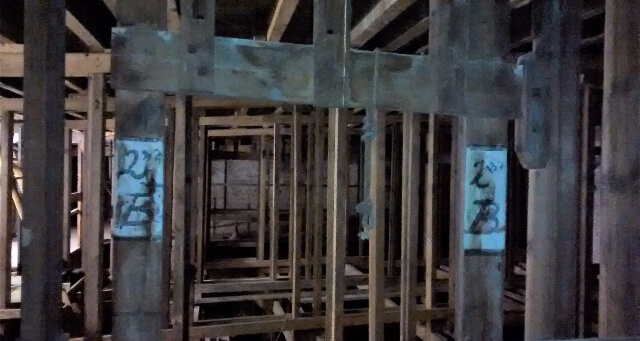With visits to all public venues, including Alexandra Palace, postponed for the foreseeable future as a result of the current coronavirus pandemic, we can read about an HHS outing to ‘The People’s Palace’ which provides an intriguing and evocative glimpse into the past.

On Saturday 7th November 1992 a party of HHS members met outside the Palm Court entrance to Alexandra Palace. The purpose of our visit was to explore parts of the Palace that had not been seen by the public for decades. This had been made possible through the kindness of Haringey councillor Lucy Craig and our guide Jacob O’Callaghan, a local journalist and author (both HHS members). As some of the places we were to visit were in an unsafe condition it was necessary to sign a waiver absolving Haringey Council against any claims for personal injury. Happily, our visit went without mishap.
The Transmitter Room
We began in the downstairs Transmitter Room. In 1936 the world’s first television service commenced at Alexandra Palace and one of the Palace’s Victorian pepperpot towers was adapted to take the famous television mast. An exhibition of early television sets and equipment, including the first zoom lens camera, had been gathered from various parts of the Palace for our benefit.
We next visited the Film Projector Room but were warned not to disturb the Palace cat which had recently given birth to five kittens. On the next floor were two large rooms which may have been entertainment rooms in an earlier era but in 1936 saw the historic contest between two rival television systems developed, on the one hand by EMI, and on the other by Scottish inventor John Logie Baird. Studio B, now a storeroom, was EMI’s laboratory and next door, in the now ruinous Studio A, was Baird’s workshop.
Television was regarded, even by Baird’s fellow countryman Sir John Reith, as little more than an interesting experiment, of no practical value. Even so, the film industry, then at its zenith, would not allow Baird to transmit any of its films and all he was allowed to use were Mickey Mouse cartoons. It was the EMI system that was finally adopted and ‘Ally Pally’ was to be the home of the new medium until much of it was transferred to new studios at Lime Grove in the 1950s.
Dereliction and decay
Moving on we were treated to a panoramic view across North London from the windows of one of the administrative offices. This was to be the prelude to the last part of our visit. We were escorted downstairs and through the busy ice rink, then through a cavernous, musty area, over which we crossed on boards laid across scaffolding. We next passed along a corridor smelling strongly of damp. At the end of the corridor, in grimy grandeur, was the Palace Theatre. It was a picture of total dereliction and decay, its once fine Egyptian-style decorations peeling away. On the stage the Safety Curtain hung partially down as if the theatre had been hastily abandoned in mid-performance like some theatrical ‘Marie Celeste’.
A variety of shows
From the opening of the Palace over a century ago the theatre saw a variety of shows and entertainments. In 1878, when Britain came close to war with Russia over the trouble in the Balkans, the Christmas pantomime ‘Dick Whittington and His Cat’ depicted the British cat victorious over the Russian rat. There are records of Wild West shows starring the ‘Chiefs’ of the Sioux and Blackfoot Indians. Among the many distinguished performers were Herbert Beerbohm Tree and Lily Langtry. It boasted some of the most innovative stage machinery and effects of its day. In spite of this a visitor on August Bank Holiday 1904 offered the comment, “that the stage is certainly an admirable one but, from the point of view of the comfort and convenience of the public, the theatre itself can only be described as an ugly, ill-ventilated, dirty old barn”.
Suffragette meeting
In 1909 a Suffragette meeting was held in the theatre by Mrs Pankhurst and Mrs Pethick-Lawrence but was broken up by a group of rowdy young men in the audience. In the 1920s, under the management of W McQueen-Pope, the theatre put on various types of entertainment including the pantomime ‘Cinderella’, complete with live deer, ponies, hounds and horses. Finally, it was rented to the entertainer and impresario Archie Pitt, first husband of Gracie Fields. He used it largely for storage and scene-painting and also for rehearsals.
The present state of Alexandra Palace is similar to that of Islington’s Royal Horticultural Hall before the advent of the late Sam Morris. Perhaps the Secret Palace will one day be restored to its former glories but until then, like the ‘Aggie’, it is ‘A building that will not go away’.
Website editor’s note
Roy Hidson, a long-standing member of HHS wrote an account of each HHS outing for many years
Image credits
Courtesy of Janet Owen